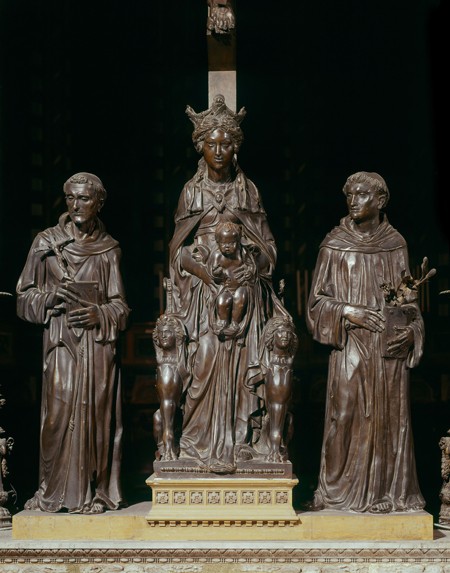These famous lines from a liturgical office honoring Saint Anthony and inscribed at his church in Padua, the Basilica del Santo, acclaim the saint. In fact, Padua enjoyed two treasures: its patron, Anthony, and its university. From the communal period (c. 1200–1318) through the mid-sixteenth century, when it was ended by the Counter-Reformation and pressure from Padua’s overlord, Venice, a rich, uniquely Paduan cultural heritage had its foundation in these two institutions. Previous studies interpret the patrons and artists of this period in terms of what they brought to Padua, never asking what the Paduan heritage offered them. Nevertheless, records from the sixteenth century, the catalog of collections by the Venetian Marcantonio Michiel, the treatise on
The university and the Santo ensured that Padua was always a cosmopolitan place of “international” culture: they attracted artists, students, scholars, and pilgrims from all over Italy and northern Europe. The university was the birthplace of Italian humanism, the cultural movement that shaped the Renaissance, and a center of the study of ancient Roman and Greek authors, particularly Aristotle. In the late
Antiquarian studies found fertile soil in Padua because of the city’s intense pride in its pre-Roman and Roman heritage. The Santo drew so many pilgrims that its riches allowed the lavish decoration of a mammoth new church to house Anthony’s relics. The Conventual Franciscans administering the church endorsed prominent, expensive commissions and made the Santo an engine of impressive patronage, drawing artists from all over Italy and Europe. In the fourteenth century, its chapels were frescoed by the Florentine Giotto and noted painters following in his tradition, including the Florentine Giusto de’ Menabuoi and the Veronese Altichiero, whose Hall of Roman Heroes in the Palazzo Carrara constitutes a chapter in my study.
In the fifteenth century, the exiled Palla Strozzi, the second-richest man in Florence, chose Padua as his residence for decades. Records of what he commissioned there remain undiscovered, but we do know that he gave an extensive collection of Greek and Latin manuscripts to Padua’s Benedictine monastery. In the sixteenth century, the Venetian humanists Pietro Bembo and Alvise Cornaro and the Mantuan Marco Mantova Benavides preferred to live in Padua, commissioning works of art, collecting antiquities, and making their residences salons of intellectual discourse.
In 1405 Padua was conquered by Venice, and for more than a century the subject city exported its culture to the overlord. Venetian administration of the empire was thin, and many Paduans continued in the government. Padua’s university became the empire’s university. The city’s major native artist at midcentury, Francesco Squarcione (c. 1395–after 1468), trained 137 students, including Andrea Mantegna, whose Ovetari Chapel I include in my book. He had them draw from casts of ancient sculpture, something no one else in Italy was doing at the time. The Santo’s board continued to seek prominent outside artists. The high altar, which consisted of seven almost life-size figures in bronze and more than a dozen figurative and symbolic bronze reliefs, was the most imposing and costly altar constructed in fifteenth-century Italy. The century’s leading artist, the Florentine Donatello, designed and executed it. The altar forms another chapter of the book.
In the sixteenth century, there were two major commissions at the Santo: the Paschal Candlestick, the work of Riccio (Andrea Briosco, 1470–1532), and the decoration of Saint Anthony’s burial chapel, both the focus of my final chapters. The candlestick is Riccio’s masterpiece. The chapel drew the most renowned sculptors from Lombardy, Florence, and Venice, who worked there all century. They created nine over-life-sized marble reliefs depicting Saint Anthony’s miracles and portraying the humble thirteenth-century saint as though he had wandered into a series of imperial Roman historical reliefs. Padua’s independent tradition and identity were eclipsed by the mid-sixteenth century, the endpoint of my book. By then, lucky Padua’s twin treasures had lost their luster.
I have focused on these monuments by considering them together in terms of their Patavinitas, or Paduan qualities. During my stay at
